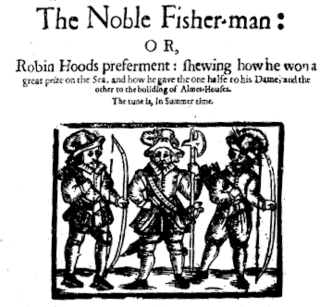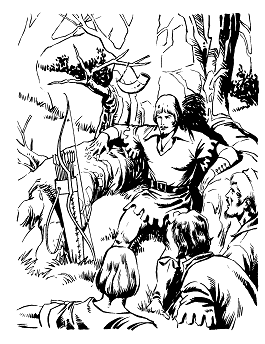
Robin Hood is a legendary heroic outlaw originally depicted in English folklore and subsequently featured in literature and film. According to legend, he was a highly skilled archer and swordsman. In some versions of the legend, he is depicted as being of noble birth, and in modern retellings he is sometimes depicted as having fought in the Crusades before returning to England to find his lands taken by the Sheriff. In the oldest known versions, he is instead a member of the yeoman class. Traditionally depicted dressed in Lincoln green, he is said to have robbed from the rich and given to the poor.

Yeoman is a noun originally referring either to one who owns and cultivates land or to the middle ranks of servants in an English royal or noble household. The term was first documented in mid-14th-century England. The 14th century also witnessed the rise of the yeoman longbow archer during the Hundred Years' War, and the yeoman outlaws celebrated in the Robin Hood ballads. Yeomen also joined the English Navy during the Hundred Years' War as seamen and archers. In the early 15th century, yeoman was the rank of chivalry between page and squire. By the late 17th century, yeoman became a rank in the Royal Navy for the common seamen who were in charge of ship's stores, such as foodstuffs, gunpowder, and sails.

Little John is a companion of Robin Hood who serves as his chief lieutenant and second-in-command of the Merry Men. He is one of only a handful of consistently named characters who relate to Robin Hood and one of the two oldest Merry Men, alongside Much the Miller's Son. His name is an ironic reference to his giant frame, as he is usually portrayed in legend as a huge warrior – a 7-foot-tall (2.1-metre) master of the quarterstaff. In folklore, he fought Robin Hood on a tree bridge across a river on their first meeting.

Sir Guy of Gisbourne is a character from the Robin Hood legends of English folklore. He first appears in "Robin Hood and Guy of Gisborne", where he is an assassin who attempts to kill Robin Hood but is killed by him. In later depictions, he has become a romantic rival to Robin Hood for Maid Marian's love.

Maid Marian is the heroine of the Robin Hood legend in English folklore, often taken to be his lover. She is not mentioned in the early, medieval versions of the legend, but was the subject of at least two plays by 1600. Her history and circumstances are obscure, but she commanded high respect in Robin’s circle for her courage and independence as well as her beauty and loyalty. For this reason, she is celebrated by feminist commentators as one of the early strong female characters in English literature.
The Bishop of Hereford is a character in the Robin Hood legend. He is typically portrayed as a wealthy and greedy clergyman who is robbed by Robin and his Merry Men.
Alan-a-Dale is a figure in the Robin Hood legend. According to the stories, he was a wandering minstrel who became a member of Robin's band of outlaws, the "Merry Men".
Will Scarlet is a prominent member of Robin Hood's Merry Men. He is present in the earliest ballads along with Little John and Much the Miller's Son.

Adam Bell was a legendary English outlaw. He and his companions William of Cloudsley and Clym of the Clough lived in Inglewood Forest near Carlisle and were figures similar to Robin Hood. Their story is told in Child Ballad 116 entitled Adam Bell, Clym of the Cloughe and Wyllyam of Cloudeslee. The basis of the tale has historical roots in the criminal activities of the Folville and Coterel gangs. At one point William of Cloudsley, who is famed as an archer, shoots an arrow through an apple on his son's head at six score paces, a feat also ascribed to William Tell and other heroes. The oldest printed copy of this ballad dates from 1505 and was printed by Wynkyn de Worde. There are notable parallels between this ballad and that of Robin Hood and the Monk, but whether either legend was the source for the other cannot be established.

Robin Hood's Death, also known as Robin Hoode his Death, is an Early Modern English ballad of Robin Hood. It dates from at the latest the 17th century, and possibly originating earlier, making it one of the oldest existing tales of Robin Hood. It is a longer version of the last six stanzas of A Gest of Robyn Hode, suggesting that one of the authors was familiar with the other work and made an expansion or summary of the other, or else both were drawing from a lost common tale. The surviving version in the Percy Folio is fragmentary, with sections missing. A more complete but later version is from the middle of the 18th century, and is written in modern English. Both versions were later published by Francis James Child as Child ballad #120 in his influential collection of popular ballads.
Robin Hood and the Butcher is a story in the Robin Hood canon which has survived as, among other forms, a late seventeenth-century English broadside ballad, and is one of several ballads about the medieval folk hero that form part of the Child ballad collection, which is one of the most comprehensive collections of traditional English ballads. It may have been derived from the similar Robin Hood and the Potter.
"Robin Hood and the Golden Arrow" is Child ballad 152. It features an archery competition for a golden arrow that has long appeared in Robin Hood tales, but it is the oldest recorded one where Robin's disguise prevents his detection.

A Gest of Robyn Hode is one of the earliest surviving texts of the Robin Hood tales. Written in late Middle English poetic verse, it is an early example of an English language ballad, in which the verses are grouped in quatrains with an ABCB rhyme scheme, also known as ballad stanzas. Gest, which means tale or adventure, is a compilation of various Robin Hood tales, arranged as a sequence of adventures involving the yeoman outlaws Robin Hood and Little John, the poor knight Sir Richard at the Lee, the greedy abbot of St Mary's Abbey, the villainous Sheriff of Nottingham, and King Edward of England. The work survives in printed editions from the early 16th century, just some 30 years after the first printing press was brought to England. Its popularity is proven by the fact that portions of more than ten 16th- and 17th-century printed editions have been preserved. While the oldest surviving copies are from the early 1500s, many scholars believe that based on the style of writing, the work likely dates to the 1400s, perhaps even as early as 1400. The story itself is set somewhere from 1272 to 1483, during the reign of a King Edward; this contrasts with later works, which generally placed Robin Hood earlier in 1189–1216, during the reigns of King Richard and King John.

The Noble Fisherman, also known as Robin Hood's Preferment and Robin Hood's Fishing, is a 17th-century ballad of Robin Hood. Unusually, it depicts Robin Hood as a hero of the sea, rather than his usual portrayal as someone who operated in the greenwood forest. It seems to have been quite popular for the first two centuries of its existence, although it eventually lost prominence and was less used in adaptations of Robin Hood from the 19th and 20th centuries. It was later published by Francis James Child in the 1880s as Child Ballad #148 in his influential collection of popular ballads.
A True Tale of Robin Hood is Child ballad 154, featuring Robin Hood and, indeed, presents a full account of his life, from before his becoming an outlaw, to his death. It describes him as the Earl of Huntington, which is a fairly late development in the ballads. It definitively places him in Richard the Lionhearted's reign.

Robin Hood and the Monk is a Middle English ballad and one of the oldest surviving ballads of Robin Hood. The earliest surviving document with the work is from around 1450, and it may have been composed even earlier in the 15th century. It is also one of the longest ballads at around 2,700 words. It is considered one of the best of the original ballads of Robin Hood.
Robyn and Gandeleyn is an English ballad. The poem is in Sloane Manuscript 2593, a document of lyrics and carols which dates from around 1450. It was first printed by Joseph Ritson in his 1790 collection Ancient Songs. It was later republished in the second half of the 19th century in an anthology of traditional English and Scottish ballads by Francis James Child known as the Child Ballads, where it is Child Ballad 115. Child also divided the continuous text into seventeen stanzas.

The Merry Men are the group of outlaws who follow Robin Hood in English literature and folklore. The group appears in the earliest ballads about Robin Hood and remains popular in modern adaptations.

Robin Hood's Grave is the name given to a monument in Kirklees Park Estate, West Yorkshire, England, near the now-ruined Kirklees Priory. It is alleged to be the burial place of English folk hero Robin Hood.

The Tale of Gamelyn is a romance written in c. 1350 in a dialect of Middle English, considered part of the Matter of England. It is presented in a style of rhymed couplets and described by Skeat as "the older and longer kind of ballad" and by Ramsey as a "rough and ready romance."












